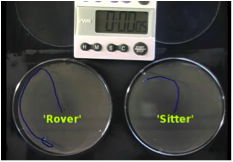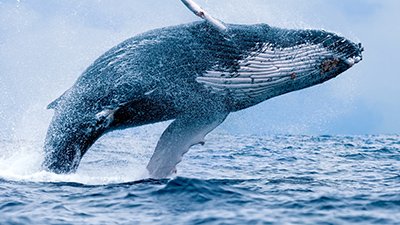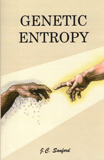
Larval Adversity Affects Fruit Fly Behavior
Larval adversity affects genetically mediated behavior in adult fruit flies.
News Source
- Futurity: “Is Early Adversity Embedded in Our Biology?”
Are personalities and behavioral patterns a product of genetics or environment early in life? This “nature versus nurture” question is likely oversimplified. Recent advances suggest the two are interrelated. Epigenetic effects, by which organisms reversibly switch genes on and off, provide a way that environment can affect genetic expression, and in some cases those effects, though temporary, may be adaptive and even passed on to offspring.1
“Biologists used to think that our differences are pre-programmed in our genes, while psychologists argued that babies are born with a blank slate and their experience writes on it to shape them into the adults they become,” says behavioral geneticist Marla Sokolowski. “Instead, the important question to be asking is, ‘How is our experience in early life getting embedded in our biology?’” She suggests that a fruit fly model may offer food for thought on this question.

Some fruit flies are real go-getters, a genetically mediated behavior typified by darting about and exploring. Such “rovers” may discover novel food sources but may also attract increased attention of predators, so the long-term effect on survival is uncertain. Others, the appropriately named “sitters,” are the couch-potatoes of the insect world. They don’t tend to dart about but prefer to sit quietly and just eat. This behavioral distinction is present in the larvae and the adults. Chronic larval malnutrition, however, radically affects the adult behavior of the flies, and it affects the rovers and the sitters differently. Image by diluvienne/Flickr, via Futurity.org.

The classic “rover” and “sitter” behavior of fruit flies, variants with respect to the “foraging” gene, is easily quantitated in the larva. After several minutes of crawling on a tasty paste, these larvae have produced very different paths, traced in blue. Watch the full video of these rovers and sitters in action in behavioral geneticist Marla Sokolowski’s laboratory at www.wwnorton.com.
Sokolowski’s studies with fruit flies show that environmental adversity—chronic nutritional deprivation—in early life produces a biological footprint that affects adult behavior. The effect varies depending on the genetic make-up of the fruit fly. Sokolowski and colleagues have identified the gene whose expression mediates this effect.
Since behavior patterns affect survival and reproductive success, such epigenetic effects are a key factor in assessing how natural selection can affect creatures. The “foraging” gene that mediates the adult behavioral consequences of larval malnutrition has homologues in a variety of invertebrates as well as in mammalian animals and in humans. It is often associated with food-related behavior.
Chronic malnutrition is a serious problem for human populations. The authors of “Biological Embedding of Early Social Adversity: From Fruit Flies to Kindergarteners” believe their fruit fly findings highlight the urgency of prioritizing resources to address global problems of childhood malnutrition, recognizing both their immediate and long-term consequences.
Sokolowski’s laboratory subjects are two groups of fruit flies with variants of the “foraging” gene (for). Appropriately named “rovers” and “sitters,” the fruit flies—both larval and adult—differ in their behavioral response to food. Rovers are aggressive explorers, darting about in a staccato of motion, as if they are searching for food but are too busy to eat much. Sitters display a more laid-back approach to finding food but tend to eat more.2 When the larvae are raised with plenty of food, this behavior continues into adulthood.
When larvae are raised with chronic dietary deprivation, however, both rover and sitter adult flies display the desperate-appearing darting about as they focus on finding food and eating it. And while the rovers’ darting behavior appears unchanged, they do eat more. Fat storage and memory are affected.3 Furthermore, while nutritionally deprived young rovers grow up to be fertile adults, nutritionally deprived sitters have diminished fertility.
“The foraging gene makes an enzyme called PKG, which is found in the fly as well as in most other organisms, including humans,” Sokolowski explains. Homologues of the foraging gene influence “energy balance, food intake, and food-related movement and learning in flies, ants, nematode worms, bees, and even humans,” she reported at an Association for Psychological Science conference in 2009.4 It also is associated with honey bee transformation from nurse to forager.5
“When faced with a nutritionally adverse environment while growing up, the levels of the enzyme dropped in flies. This told us that the foraging gene listens to its environment,” says Sokolowski. “This is the first volume of collected research to provide a substantial and comprehensive picture of the interaction between experience and biology in the early years. Developmental neuroscience is extraordinarily intricate and complex.”
Sokolowski and colleagues, like most evolutionists, believe the foraging gene and its homologues demonstrate the common ancestry of living things.
Sokolowski and colleagues, like most evolutionists, believe the foraging gene and its homologues demonstrate the common ancestry of living things. They therefore write that “reasoning from evolutionary biology” may help explain “individual variation in how humans react to their environment.”6 As we regularly point out, however, common design—including similarity of some genes in a wide variety of organisms—does not prove common ancestry but is consistent with the existence of a common Designer. God created all kinds of living things to live in this world and to be able to vary within their kinds. No evolution of new kinds of organisms is supported by this research.
The discoveries of epigenetics will doubtless continue to shed light on the genetic and environmental influences on animals and humans. And learning of possible long-term effects of childhood malnutrition on survivors only increases the urgency of such human tragedy, yet these issues have nothing to do with evolution.
Sokolowski and colleagues acknowledge the enormous complexity and the vast number of variables that can influence fruit fly behavior. And humans are still more complex. We must be cautious and avoid extrapolating to unwarranted conclusions about humans. An evolutionary bias could increase the likelihood of this error.
Much work remains to be done in exploring the interplay of genetic expression and environment as well as the potential for long-term impact on behavior and personality in both animals and humans. There is non-material spiritual aspect to human personality and behavior, and we are not just the sum of our parts and our past. Every person is a sinner who is accountable to our Creator, and each of us—privileged or deprived—needs the grace offered through Jesus Christ.
For More Information: Get Answers
Remember, if you see a news story that might merit some attention, let us know about it! (Note: if the story originates from the Associated Press, FOX News, MSNBC, the New York Times, or another major national media outlet, we will most likely have already heard about it.) And thanks to all of our readers who have submitted great news tips to us. If you didn’t catch all the latest News to Know, why not take a look to see what you’ve missed?
(Please note that links will take you directly to the source. Answers in Genesis is not responsible for content on the websites to which we refer. For more information, please see our Privacy Policy.)
Footnotes
- Epigenetic changes provide ways for organisms to respond to environmental changes by reversibly switching genes on and off. The actual genes do not change. Usually this process involves modification of chemical tags on DNA or on the histone proteins that keep DNA packed properly. A typical epigenetic change involves attaching carbon-containing methyl groups. And while acquired traits cannot be inherited, geneticists are increasingly finding epigenetically regulated traits that can. Heritable non-genetic traits include the color of flowers, fruit fly eyes, and mouse fur. Even humans may be affected by epigenetic changes, as shown in a study of psychiatric illness occurring in single identical twins. See “Why do identical twins not uniformly manifest heritable diseases?,” “Non-Genetic Traits Lengthen Roundworm Life Span,” “Epigenetic Code: Hidden DNA,” “Epigenetic On-Off Switches,” “Uniqueness of Humans,” and “Angry Birds” for more information and examples.
- E. Wargo, “The New Genetics,” Observer 22, no. 6 (July/August 2009), http://www.psychologicalscience.org/index.php/publications/observer/2009/july-august-09/the-new-genetics.html.
- Ibid.
- Ibid.
- M. J. Fitzpatrick and M. B. Sokolowski, “In Search of Food: Exploring the Evolutionary Link Between cGMP-Dependent Protein Kinase (PKG) and Behaviour,” Integrative & Comparative Biology 44, no. 1 (2004): 28–36, doi: 10.1093/icb/44.1.28.
- J. G. Burns et al., “Gene–environment interplay in Drosophila melanogaster: Chronic food deprivation in early life affects adult exploratory and fitness traits,” PNAS 109 (October 16, 2012), http://www.pnas.org/content/109/Supplement_2/17239.full.pdf.
Recommended Resources

Answers in Genesis is an apologetics ministry, dedicated to helping Christians defend their faith and proclaim the good news of Jesus Christ.
- Customer Service 800.778.3390
- © 2024 Answers in Genesis





